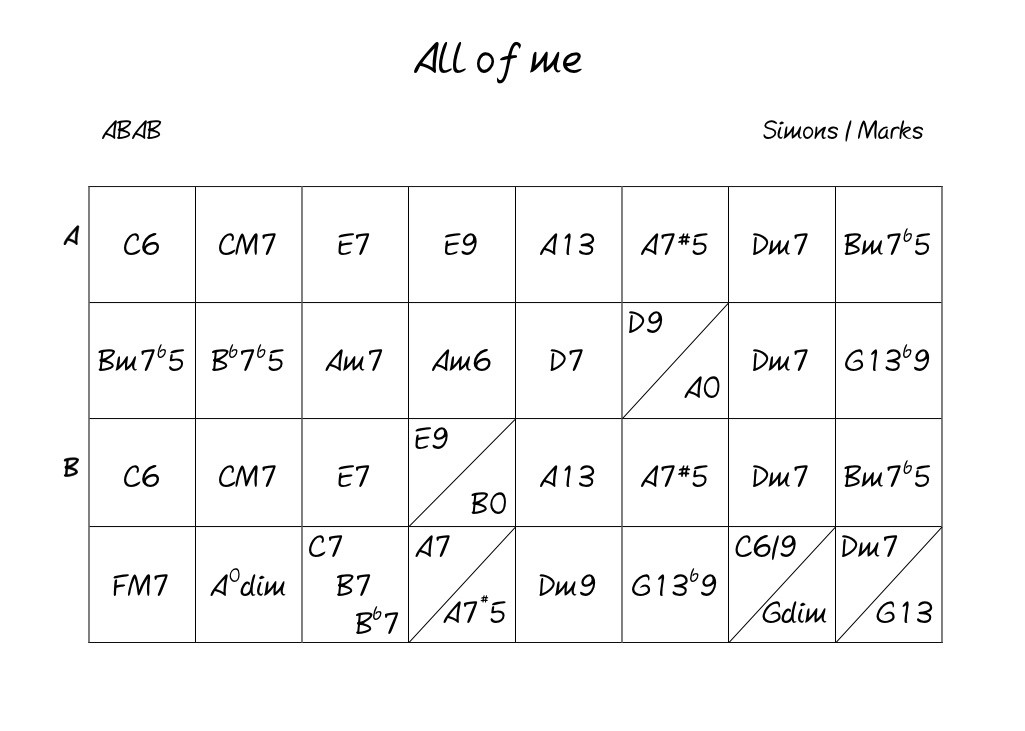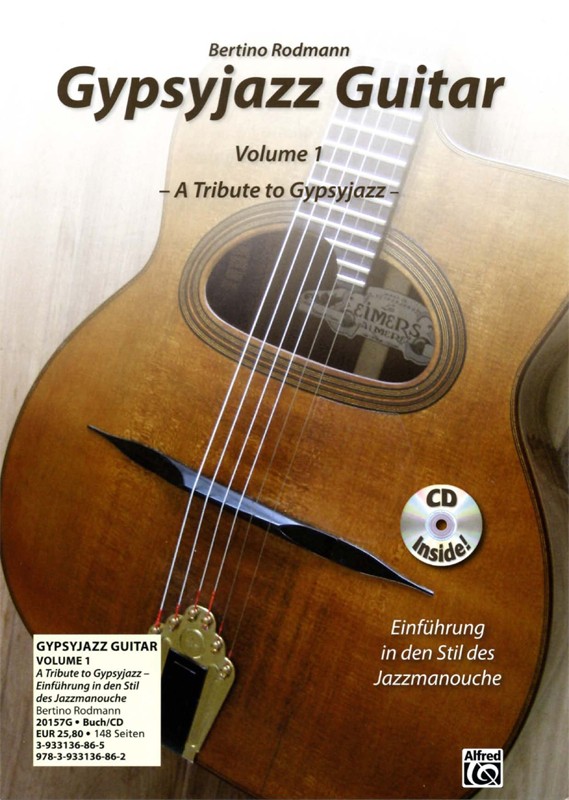Accompaning, substitutions and changes in songs
In this article ” Accompaning, substitutions and changes in songs ” we like to focus on general accompaning in Jazz-tunes, sometimes also called “Comping”. The accompaniment of any tune by guitarrists in Jazz and especially in Jazz-Manouche is one of the most importatnt issues of all. Specially in Jazz-Manouche, which also has been called “String-Jazz”, Jazz that has been played on stringed instruments solely.

In the early days Jazz-Combos mostly played with a Banjo or simple guitar, beeing pure accompaniment instruments, just creating a backing rhythm with it. Thus was the role of the guitar these days.
That dramatically changed in the early years of the 20th century especially by guitarrists like Django Reinhardt, Sarrane or Baro Ferré in Europe or famous players like Charlie Christian in the USA.

They introduced the guitar to music as a Solo-Instrument, changing it from pure accompaniment to a more versatile use.

The first setups of the Quintette du HotClub de France were complete innovations for his time, as they were playing Jazz solely with string-instruments, thus creating the name “String-Jazz”, in comparison to all other Jazzbands of that time who were playing with brass-instrumens mostly (Clarinette, Saxophone, Trumpets).
The Quintette du HotClub de France also didnt utilize Drums or any bandsetups alike the usual bands of that time did (Drums, Bass, Brass, Banjo/Guitar), although Django Reinhardt experimented with drums in later bandsetups after the war. That said it is clear that the role of the rhythmguitar developed to be one of THE leading and central elements in Gypsyjazz or Jazz-Manouche.
So what is good Rhythm-accompaniment?
Jazz (and of course Jazz-Manouche) is all about Improvisation. That means also that the Soliste is extremely dependent on a solid basis on which he could settle his Improvisations onto. This base will be created by the rhythmguitar in Jazz-Manouche together with the Bass.
“Good” accompaniment, despite playing a very straight and moving rhythm (It dont mean a thing if it aint got that swing!), means to also be able to create interesting chordchanges inside the usual turnarounds of tunes, thus inspiring the solist for his own ideas for improvisation…
Praktical use
For our example let´s take the Song “All of me” which is part of the Standard-Repertoire of GJ. These are the “normally used” chords of the “All of me” turnaround:

Of course one can create accompaniment to the tune “All of me” with these chords, getting along well in any Jamsession with it.
But it would be as well possible to extend the chordchanges by more substitutions and more extended chords to create a much more interesting enviroment with more freedom and esprit for the soloists.
Here is an example of such an extended “interesting” accompaniment which we will take a closer look on further down:

Let´s take a closer look at these changes now.
Not only we see more chords in example 2, but those existent creating some “guidelines” by the way of triggering the chords in it´s order, on which the solist could pull his inspiration from.
By the coloured change of C6 to CM7 we break up the changes for greater ways of improvisation, the soloist may as well play over C-sharp as well as C-Major and their substitutes.
The substitution E7 – E9 (may be turned around as well) creating a more open freedom for scales or arpeggios.
As well the change of A7 to A13 – A7#5 creating some tention to release again into Harmony by the following Dm7 – Bm7b5.
Especially interesting is the change at 9th bar from Bm7b5 to Bb7b5 instead staying on pure E7 for 2 bars. Here the whole power and bandwith of chordsubstitution shows up.


Also in bar 27 at the change C7, B7, Bb7, A7, A7#5 the strict and boring pattern of play 4 bars the same chord is beeing split up, thus more flowing fluently from root to sixth together with the bassline.
A Dm9-chord instead of Dm7 is creating a more modern approach, the G13b9 and the following changes summarize the turnaround with a more coloured motive.
When choosing chords changes and substitutions it is crucial to not play chords that a located on different areas of the neck, but staying in one close area all together, thus taking care to a more “compact” chord accompaniment. Leading motives create interesting melodylines (e.g. when beeing connected by “leading tones”). Example: Dm7 – G13b9 – C6/9 or else, leading tones are F, E and D.
Of course you will have to take care not to “overdo” the subsitutions, as this may become a dangerous task too by adding too many chords that lead into confusion. A natural blend of chords may do the trick, beeing the salt in the soup.
You may also want to read or download our JM-Chord-Lexicon with interesting chords and substitutions.

ADVERTISING
 “Gypsyjazz Guitar – a tribute to Gypsyjazz“
“Gypsyjazz Guitar – a tribute to Gypsyjazz“
Gypsy-Jazz bzw. Jazz-Manouche ist der erste in Europa entstandene Jazzstil.
Seine Einflüsse kommen aus dem französischen Musette-Walzer, dem ungarischen Çsardas oder dem spanischen Flamenco, sowie der Sinti-Musik selbst, die von den Sinti-Musikern in Swing-Phrasierung interpretiert wurde.
Ziel des Buches: Nicht nur eine umfassende Gitarrenschule für Gypsy-Jazz Gitarre zu verfassen, die die rhythmischen und solistischen Aspekte der Gypsyjazz Gitarren-Spielweise vermittelt, sondern auch den Respekt gegenüber der uralten Tradition der Sinti.
Inhalt Teil 1: Rhythm Guitar: Comping, La Pompe-Rhythmus, Dead Notes, Gypsychords, Voicings, Blues-Kadenz, Chord Substitution
Inhalt Teil 2: Solo Guitar: Reststroke Picking, Arpeggio Picking, Sweptstroke Picking, Skalen, Arpeggien, Solo Licks
Verlag: Alfred Music Publishing GmbH; Auflage: 1 (15. Oktober 2011)
Sprachen: Deutsch / English ISBN-10: 3933136865 – ISBN-13: 978-3933136862
148 Seiten, mit Play-alongs und Noten & Tabulatur + Audio-CD Preis: 25,80
Erhältlich bei Amazon, Alfred Verlag oder www.bertino-guitarrist.com
